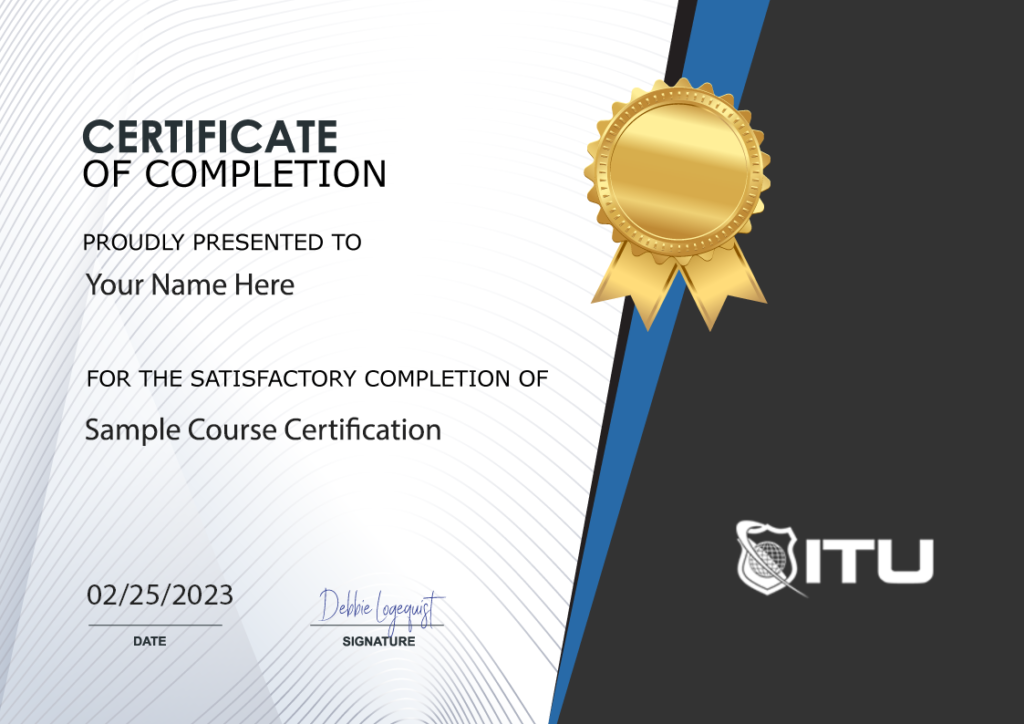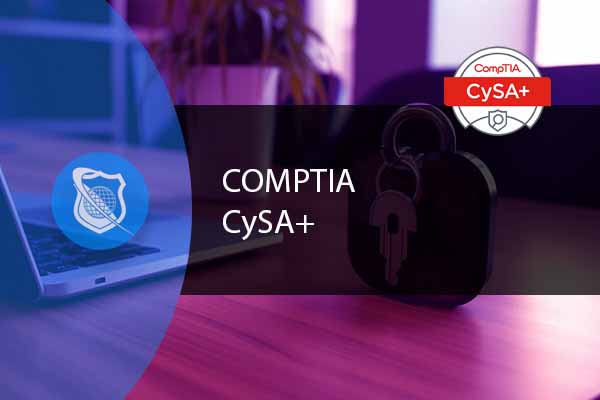CompTIA Cybersecurity Analyst (CySA+)
In this IT course you will learn how to configure and use threat-detection tools, perform a threat intelligence analysis, and interpret the results with the end goal of securing an organizations applications and systems with your security solutions. This IT course covers the exam objectives for the CompTIA Cybersecurity Analyst , or CySA+ exam.
Included In This Course



Closed Captions



Certificate of Completion
Leverage intelligence and threat detection techniques strategies to gain an edge.
Cybersecurity certification is one of the hottest IT-related certifications today due to all the cybersecurity threats we face each day from bad actors. The CompTIA Cybersecurity Analyst, also known as CompTIA CySA+, is a CompTIA certification. CySA+ is focused on cyber security fundamentals and arming you with knowledge and skills required to perform the following:
- Configure and use threat-detection tools to develop threat intelligence analysts
- Perform data analysis and deploy threat detection techniques
- Interpreting the results and present a vulnerability analysts along with vulnerability management activities to mitigate cyber threats.
Securing an organization’s network environments applications and systems is the primary goal of a Cybersecurity Analyst. hHaving the practical knowledge to identify and deploy effective IT environments that protect agents network attack strategies will set you apart from your peers in your IT career.
About CompTIA CySA+
The CompTIA CySA+ is a vendor-neutral certification. A student normally has three to four years of experience in a related IT field as well as a Security+ or equivalent knowledge. In this regard, the CompTIA CySA+ lies between the CompTIA Security+ and CompTIA Advanced Security Practitioner (CASP) exams. It is an excellent go-between to tackle before diving into the CASP, but when the CompTIA Security+ isn’t enough.
Cybersecurity certification is an ongoing requirement for government agencies. The CompTIA CySA+ was developed with a focus on meeting government requirements to certify IT, workers or contractors. With a Cybersecurity certification, you display an understanding of security best practices and protocols beyond that which is provided by the Security+ certification. You will prove a level of expertise beyond that of basic security practices that are followed when using a computer.
This allows any IT employee to prove a better understanding of enterprise security practices, and the necessary tools needed for organizational risk mitigation. The modules of this IT course align with the official objectives of the certification. The course expands past the scope of the certification. It also provides real-life examples and lead-ins to direct further study. This will give students an easier understanding of the material for the certification as well as a basic understanding to apply to real-life applications.
We encourage you to visit the CompTIA website for full details on theCySA+ certification and exam code CS0-001.
Key Term Knowledge Base: Key Terms Related to CompTIA Cybersecurity Analyst (CySA+)
Understanding key terms is vital for anyone pursuing the CompTIA Cybersecurity Analyst (CySA+) certification or working in the cybersecurity field. These terms are fundamental to grasping the concepts and practices in cybersecurity.
| Term | Definition |
|---|---|
| CompTIA CySA+ | A certification focusing on cybersecurity skills, including threat detection, data analysis, and incident response. |
| Threat Detection | Identifying potential threats in a cybersecurity context. |
| Data Analysis | The process of examining, cleansing, transforming, and modeling data to discover useful information in cybersecurity. |
| Vulnerability Management | Identifying, classifying, prioritizing, remediating, and mitigating software vulnerabilities. |
| Incident Response | A method of handling and investigating a cybersecurity incident or breach. |
| Cybersecurity | The practice of protecting systems, networks, and programs from digital attacks. |
| Network Reconnaissance | The collection of information about a network to identify potential vulnerabilities or attack vectors. |
| Security Architecture | The design and structure of systems that monitor and control security aspects of an organization. |
| Risk Mitigation | Strategies and techniques used to manage and minimize cybersecurity risks. |
| Forensics | Techniques used to collect, preserve, and analyze data in the context of cybersecurity incidents. |
| Identity and Access Management (IAM) | Processes and technologies to manage and monitor user access to critical information. |
| Compliance | Adhering to laws, regulations, guidelines, and specifications relevant to cybersecurity. |
| Encryption | The process of converting data into a code to prevent unauthorized access. |
| Threat Intelligence | Knowledge used to understand and predict cybercriminal capabilities and goals. |
| Penetration Testing | Simulated cyber attacks on computer systems to evaluate security. |
| Malware | Malicious software designed to disrupt, damage, or gain unauthorized access to computer systems. |
| Security Policy | A set of rules and practices that specify how an organization manages and protects its information assets. |
| Vulnerability Scan | A software tool that assesses the security weaknesses in networks, systems, or applications. |
| Incident Management | The process of identifying, analyzing, and correcting hazards to prevent a future re-occurrence of an incident. |
| Cybersecurity Framework | A set of guidelines and best practices to manage cybersecurity risks. |
These terms are essential for anyone studying for the CompTIA CySA+ certification or working in the field of cybersecurity. They form the basis for a strong understanding of the complex cybersecurity landscape.
Frequently Asked Questions About CompTIA Cybersecurity Analyst (CySA+)
What is the CompTIA CySA+ course about?
The CompTIA CySA+ course offered by ITU Online is focused on cybersecurity fundamentals. It provides you with the knowledge and skills to configure and use threat-detection tools, perform data analysis, deploy threat detection techniques, and interpret the results. The course also trains you in presenting a vulnerability analysis and managing vulnerability to mitigate cyber threats. The ultimate goal is to secure an organization’s network environments, applications, and systems.
What is the structure of the course?
The course consists of 17 training hours, 67 videos, and 4 topics. Additionally, there are 250 practice questions included in the course to help you assess your understanding and readiness.
What is the recommended background for this course?
The CompTIA CySA+ is a vendor-neutral certification. Typically, a student taking this course should have three to four years of experience in a related IT field, as well as a Security+ certification or equivalent knowledge.
How do I access the course materials?
The CompTIA CySA+ course is available on-demand. You can get access to this training and over 2,500 hours of other content with ITU Online’s All Access Monthly Subscription. There’s a 7-day free trial period during which you can access the course with no obligation, and you can cancel anytime.
Can I take this course if I am located outside of the United States?
Yes, you can take this course from anywhere in the world as long as you have an internet connection. The course is online and on-demand, meaning you can access it at any time that’s convenient for you.
Are there any other courses offered by ITU Online that could complement the CompTIA CySA+ course?
Yes, ITU Online offers a wide range of courses that could complement your cybersecurity education, including courses in other CompTIA certifications, network administration, data administration, development and programming, and more. We also offer various IT training bundles on sale
Blogs of Interest Related to This Course
- Securing the Digital Future: Navigating the Rise of Remote Cybersecurity Careers
- 10 Essential Cybersecurity Technical Skills for Success
- Is CySA+ Worth It?
- CySA+ Objectives - A Deep Dive into Mastering the CompTIA Cybersecurity Analyst (CySA+)
- Deciding Your Future in Cybersecurity: CEH vs Pentest+
- CISM vs CISSP: Which Cybersecurity Certification is Right for You?
- Cybersecurity Online Programs: How to Choose the Right Course Along with the Top 5 Courses
- CompTIA Security Plus Objectives: The Ultimate Resource for Learners
- CASP Certification: The Exam Objectives
- What Is CySA+? Let's Define and Compare Cybersecurity Certifications
Proudly DisplayYour Achievement
Upon completion of your training, you’ll receive a personalized certificate of completion to help validate to others your new skills.
CompTIA Cybersecurity Analyst (CySA+) Course Content
Module 1: Threat Management
- Introduction
- Given a scenario, apply environmental reconnaissance techniques using appropriate tools and processes Part 1
- Given a scenario, apply environmental reconnaissance techniques using appropriate tools and processes Part 2
- Given a scenario, apply environmental reconnaissance techniques using appropriate tools and processes Part 3
- Given a scenario, apply environmental reconnaissance techniques using appropriate tools and processes Part 4
- Given a scenario, apply environmental reconnaissance techniques using appropriate tools and processes Part 5
- Given a scenario, apply environmental reconnaissance techniques using appropriate tools and processes Part 6
- Given a scenario, apply environmental reconnaissance techniques using appropriate tools and processes Part 7
- Given a scenario, apply environmental reconnaissance techniques using appropriate tools and processes Part 8
- Given a scenario, apply environmental reconnaissance techniques using appropriate tools and processes Part 9
- Given a scenario, analyze the results of a network reconnaissance Part 1
- Given a scenario, analyze the results of a network reconnaissance Part 2
- Given a scenario, analyze the results of a network reconnaissance Part 3
- Given a scenario, analyze the results of a network reconnaissance Part 4
- Given a scenario, analyze the results of a network reconnaissance Part 5
- Given a network-based threat, implement or recommend the appropriate response and countermeasure Part 1
- Given a network-based threat, implement or recommend the appropriate response and countermeasure Part 2
- Given a network-based threat, implement or recommend the appropriate response and countermeasure Part 3
- Given a network-based threat, implement or recommend the appropriate response and countermeasure Part 4
- Explain the purpose of practices used to secure a corporate environment Part 1
- Explain the purpose of practices used to secure a corporate environment Part 2
- Explain the purpose of practices used to secure a corporate environment Part 3
- Explain the purpose of practices used to secure a corporate environment Part 4
Module 2: Vulnerability Management
- Given a scenario, implement an information security vulnerability management process Part 1
- Given a scenario, implement an information security vulnerability management process Part 2
- Given a scenario, implement an information security vulnerability management process Part 3
- Given a scenario, implement an information security vulnerability management process Part 4
- Given a scenario, implement an information security vulnerability management process Part 5
- Given a scenario, implement an information security vulnerability management process Part 6
- Given a scenario, implement an information security vulnerability management process Part 7
- Given a scenario, analyze the output resulting from a vulnerability scan Part 1
- Given a scenario, analyze the output resulting from a vulnerability scan Part 2
- Compare and contrast common vulnerabilities found in the following targets within an organization Part 1
- Compare and contrast common vulnerabilities found in the following targets within an organization Part 2
- Compare and contrast common vulnerabilities found in the following targets within an organization Part 3
Module 3: Cyber Incident Response
- Given a scenario, distinguish threat data or behavior to determine the impact of an incident Part 1
- Given a scenario, distinguish threat data or behavior to determine the impact of an incident Part 2
- Given a scenario, distinguish threat data or behavior to determine the impact of an incident Part 3
- Given a scenario, prepare a toolkit and use appropriate forensic tools during an investigation Part 1
- Given a scenario, prepare a toolkit and use appropriate forensic tools during an investigation Part 2
- Given a scenario, prepare a toolkit and use appropriate forensic tools during an investigation Part 3
- Given a scenario, prepare a toolkit and use appropriate forensic tools during an investigation Part 4
- Given a scenario, prepare a toolkit and use appropriate forensic tools during an investigation Part 5
- Explain the importance of communications during the incident response process
- Given a scenario, analyze common symptoms to select the best course of action to support incident response Part 1
- Given a scenario, analyze common symptoms to select the best course of action to support incident response Part 2
- Given a scenario, analyze common symptoms to select the best course of action to support incident response Part 3
- Given a scenario, analyze common symptoms to select the best course of action to support incident response Part 4
- Summarize the incident recovery and post-incident response process Part 1
- Summarize the incident recovery and post-incident response process Part 2
- Summarize the incident recovery and post-incident response process Part 3
- Summarize the incident recovery and post-incident response process Part 4
Module 4: Security Architecture and Tool Sets
- Explain the relationship between frameworks, common policies, controls, and procedures Part 1
- Explain the relationship between frameworks, common policies, controls, and procedures Part 2
- Explain the relationship between frameworks, common policies, controls, and procedures Part 3
- Explain the relationship between frameworks, common policies, controls, and procedures Part 4
- Given a scenario, use data to recommend remediation of security issues related to identity and access management Part 1
- Given a scenario, use data to recommend remediation of security issues related to identity and access management Part 2
- Given a scenario, use data to recommend remediation of security issues related to identity and access management Part 3
- Given a scenario, use data to recommend remediation of security issues related to identity and access management Part 4
- Given a scenario, review security architecture and make recommendations to implement compensating controls Part 1
- Given a scenario, review security architecture and make recommendations to implement compensating controls Part 2
- Given a scenario, review security architecture and make recommendations to implement compensating controls Part 3
- Given a scenario, use applications security best practices while participating in the Software Development Life Cycle (SDLC) Part 1
- Given a scenario, use applications security best practices while participating in the Software Development Life Cycle (SDLC) Part 2
- Overview
- Conclusion
| 5 star | 82 | 82% |
| 4 star | 17 | 17% |
| 3 star | 1 | 1% |
| 2 star | 0% | |
| 1 star | 0% |
Sorry, no reviews match your current selections

Subscribe To All-Access
Lock In $16.99 / Month Forever
Access this course and over 2,900 hours of focused IT training. Start your first month for only $1.00. Then lock in only $16.99 / month for life.
- Get Every Course
- Free Updates / New Content Added
- 2,900+ Hours of IT Training
- Price Lock Guarantee
- Games / Flashcards
- 22,000+ Practice Questions
- AI Study Buddy
- Certificates of Completion
$49.99 $16.99 Monthly
$49.00




good
Smooth delivery and easy access to LMS. Good to see that the LMS offers progress tracking. Would be great if badges were offered on completion of courses to share via Credly to future employers.